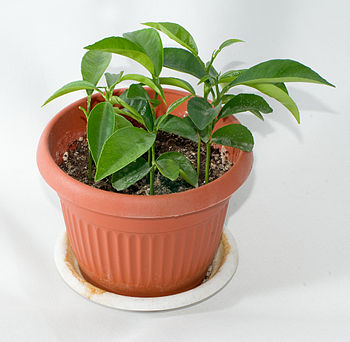But citrus is sometimes grown where the climate gets a little colder. In these climates, the trees need to be brought inside until they are mature enough to keep them from getting too cold. So, yes, citrus trees can be grown indoors. Let's take a look at how to start growing citrus from a seedling, how to grow citrus indoors, and finally, some interesting citrus garden fun.
Choose the Seeds
 |
| Mandarin (Citrus reticulata) in flowerpot. (Photo credit: Wikipedia) |
Cut the citrus open to expose the seeds. Remove the seeds and wash lightly. Place the ‘clean’ seeds into a bowl or glass of fresh water. This is in order to sort good seeds from bad seeds. Discard any seeds that immediately float to the surface or are cut or split, as these are probably not going to germinate. Once you have culled your seeds, they can be either germinated or dried and stored in a paper envelope until you're ready for them.
Time to Germinate
Citrus seeds require a period of dormancy in cold temperature in order to initiate germination. To get your seeds 'in the mood' to germinate, you'll need to refrigerate them.
Prepare a little germination chamber by first laying the seeds on a damp paper towel, then fold the paper towel over the seeds, completely encasing the seeds inside. Now slip the paper towel into a ziploc plastic bag or airtight food container, then place in the produce drawer in your refrigerator. It should take about four to six weeks to germinate the seeds this way.
Time to Plant
When you unwrap your germinated seeds, you'll see a little sprout. It's time to condition your seeds and prepare your pots. Put the seeds in cool, clean fresh water and allow to soak for a few hours. Meanwhile, prepare small pots, about 2 to 3 inch size, one for each seed. Choose a tray for draining that fits under the pots. If you have a somewhat sunny, not scorching hot, windowsill, a long narrow tray with several small pots works well.
Fill the pots with a handful of pebbles in the bottom, then a light, fluffy potting soil. Moisten the soil so it's damp, but not waterlogged. Carefully take each seed, sprout side up, and push a hole in the soil, then drop the seed in, making sure most of the sprout is above the soil. Tap down lightly around the sprout and gently sprinkle a little water in each pot.
Watch the sunlight and water carefully. The sprouts need to be warm, not hot. The soil needs to be moist, not waterlogged.
The seedlings can be left in these pots until they are about 4 to 6 inches tall. Then you'll need to prepare bigger pots, but be sure to only go up one size. A plant that has too much room for the roots won't spend any time growing up. It will put all it's effort into growing more roots to fill the pot. You need a good amount of green leaves for your plant to mature, so you want your plant to grow upward and not just into more roots.
 |
| Unripe Meyer lemon on tree. (Photo credit: Wikipedia) |
Once your citrus plants are in their next size pot, you can start to 'harden off' the plant if weather in your area permits. This just means they can be moved outside to a sheltered area where they will get some warm, indirect sunlight and gentle breezes. Remember, they're still baby plants, so avoid hot sun and strong winds.
If you're ambitious, you can take the plants out daily, then return them to shelter overnight. It all depends on your weather and your set up. You will want to keep in mind your citrus plant's native lands when you consider the environment you give them. Citrus plants like warm days and cool nights, so try to mimic that for them.
When the plants appear to be toppling over in their pots, you'll need to transplant them again. Remember just to go up one pot size at a time. You may do this several times until your citrus plant has reached the desired size. Most people who grow citrus fruit at home choose small varieties of lemons and limes to start with because the plants are smaller and easier to handle.
Once your citrus plant has reached a healthy size, you can choose a spot outside for it to live during temperate seasons. During months where freezing weather occurs, you'll need to move your plants inside. You'll just need to make sure they get enough sunlight and water. You'll also need to research organic fertilizers and choose one that works for you to keep the plant nourished and fed.
Blossoms and fruit may not appear for several years. Don't be frustrated. Let the plant mature, keep it healthy, and you will be rewarded for your patience with tasty citrus fruits for your kitchen!
No comments:
Post a Comment
We welcome comments and suggestions!